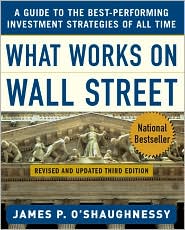
Leafing through James O'Shaughnessy's book What Works on Wall Street last night in Barnes & Noble, I came across this:
Almost all the superior returns offered by small stocks come from microcap stocks with market capitalizations below $25 million
[...]
The microcap returns absolutely dwarf their nearest competitor, the $25 million to $100 million group.
O'Shaughnessy also writes that the sub-$25 million market cap stocks outperform all other market caps on a risk-adjusted basis as well. This is consistent with the research by Athanasios Bolmatis and Evangelos Sekeris we referred to in a post a few months ago ("Why Worry about Small, Thinly-Traded Stocks"). Bolmatis and Sekeris conducted a study that found that,
Stocks that have no-trade days outperform other stocks by a wide margin, even after correcting for their higher risk as captured by their larger betas.
Even though sub-$25 million market cap stocks have the highest risk-adjusted returns as a group, O'Shaughnessy writes that they are almost impossible to buy, and cites a liquidity study conducted by Lehman Brothers in the 1990s in support of this. This conclusion seems a little dated. Professional value investors such as Paul Sonkin of Hummingbird Value and Aaron Edelheit of Sabre Value have successfully invested in sub-$25 million market cap stocks, and individual investors can buy them as well, if they have patience and use limit orders.



5 comments:
If a stock has a bid-ask spread of
$1 - $1.40 how would you measure its performance?
If it had a bid-ask spread of $1.30 - $1.70 12 months later did it go up? down? or nowhere?
Another complication in measuring micro-cap performance is the 'survivorship bias'. Companies that fail [go to zero] get delisted and their bad performances disappear along with their stock quotes.
I'm not sure what methodology O'Shaughnessy used to measure the performance of small stocks with large spreads. Next time I'm in B&N, I'll check the book and see if it explains this. My guess would be that he simply used closing prices.
Regarding survivorship bias, this is an issue with larger stocks as well.
Good lesson. I tell people next time you start to think microcaps are risky just have a look at some mega large caps...Fannie, Rh Donnelly, GM, AIG, etc.
Notice that they equate risk with beta here--i.e., they're referring to market risk and not investment risk.
***
By the way, Dave, any comment on the recent AIG news
"Notice that they equate risk with beta here--i.e., they're referring to market risk and not investment risk."
Bolmatis and Sekeris define risk the same way most finance academics due, as volatility. O'Shaughnessy does as well. They take into account volatility to calculate risk-adjusted returns. I disagree with using volatility as a synonym for risk, but it's immaterial for the purposes of this post, since both the team of Bolmatis and Sekeris and O'Shaughnessy found the smallest stocks to have, as a group, the highest absolute returns as well as the highest risk-adjusted returns.
"By the way, Dave, any comment on the recent AIG news"
Thanks for the link.
Post a Comment